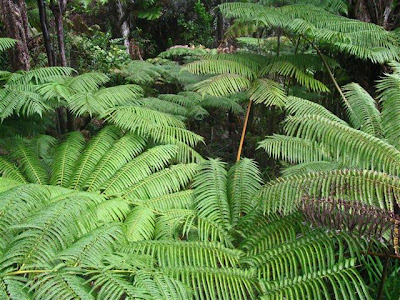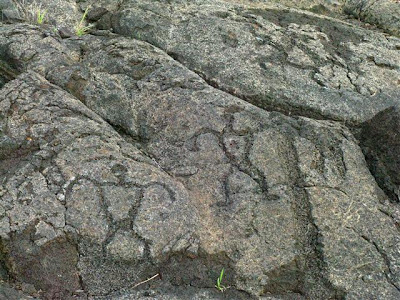Hawaii Volcanoes National Park
encompasses two active volcanoes: Mauna Loa and Kilauea. Mauna Loa,
which last erupted in 1984, is the world's most massive volcano,
rising to an elevation of 13,679 ft (neighboring peak Mauna Kea is
slightly taller at 13,803 feet, but Mauna Loa is broader and has
greater volume). If you measure from either mountain's underwater
base rather than from sea level they are taller than Mount Everest.
Kilauea sort of sticks out of the side
of Mauna Loa and was once considered part of it, but now is deemed a
separate volcano. It is one of the world's most active volcanoes –
possibly the most active – having 34 eruptions since 1952,
including the most recent event which began in 1983 and has continued
to this day. Kilauea is said to be the home of Pele, the Hawaiian
volcano goddess. The volcanic glass fibers you find about are known
as Pele's hair.
When I was here 18 years ago I could
hike right up to the flowing lava on Kilauea's south flank, but now
it is much less accessible, unless you spring for a helicopter
flight. You can see a bit burbling up in the summit caldera –
especially after dark – but hikes around that area are off limits
right now due to high levels of sulfur dioxide venting (even though
we are probably immune, having already survived high levels of
noxious fumes from Tamar's dog the last several weeks). We were at
least able to hike around an outer portion of the caldera, where the
thin black crust reminds one of the remnants of an oven cleaning
cycle and crunches satisfyingly under your feet. Passing from the
barren lava fields to the surrounding rainforest makes for a striking
contrast. We also walked through a lava tube, which is formed as the
outer layers of a subterranean flow cool and harden as the warmer and
still molten inner portion flows out, leaving a tubular structure or,
as we like to think of it, Pele's colon.
We stayed at a very nice apartment
while touring the park, a roomy place in the forest with the use of a
hot tub. But the plentiful rain that feeds the lush rainforest
surroundings here reinforce our decision to choose instead the more
modest rainfall of Hawi. Here in cool, damp Volcano you are
constantly fighting towels that won't dry and sofa cushions that
smell mildewy. If a place needs a dehumidifier it is not a place we
want to live.
Steam Vents
Sulfur Vents
Kilauea Caldera
The same - more dramatic at night
A tourist ponders the gates of hell
Deborah in the caldera
Ferns find a foothold in the cracks of the caldera floor
Fern, baby, fern
Buckled floor of Kilauea Iki Crater
Petroglyphs










The last time we were there -- a year and a half ago -- we couldn't see Kilauea erupting because the steam/smoke was too thick. But many years ago we walked from Volcano House, where we spent the night, down to where the lava was pouring into the ocean. We didn't have a flashlight and it was raining, so it was a VERY dark walk. When we returned the next day we discovered we had walked within a very few yards of a cliff over the ocean. Scary in retrospect. But in the daylight we returned and we able to walk right up to the lava flow. After awhile a ranger took a small group of us on a walk right on top of the flow. It was black and hardened under our feet, but we could look right down through cracks to the hot lava flowing under us. Even at the time I couldn't believe they were allowed to do that. I was very disappointed a few years later when they kept us at least 100 yards away from the flow. Not nearly the same drama!
ReplyDelete